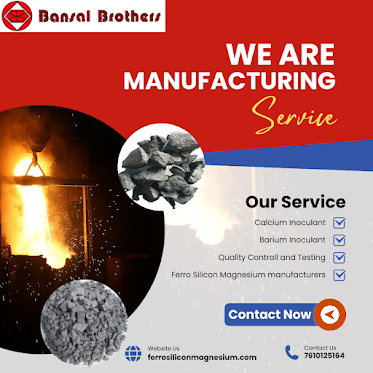High Recovery for Ferro Silicon Magnesium: Boosting Output and Quality
Ferro Silicon Magnesium (FeSiMg) is a vital alloy in the steel and foundry industries, principally utilized as an inoculant and nodulizer in the manufacturing of ductile iron and cast iron. The efficiency of this alloy, however, relies greatly on the recovery rate of magnesium during the alloying process. A high recovery for ferro silicon magnesium not only assures effective use of raw materials but also increases the overall quality and production of the end product.
Importance of High Recovery in Ferro Silicon Magnesium
In metallurgical operations, the word "recovery" refers to the proportion of a certain element or compound that is maintained during smelting, refining, or alloying. In the case of FeSiMg, excellent magnesium recovery is crucial for numerous reasons:
Maximizing Material Efficiency: Magnesium is volatile at high temperatures, which may lead to considerable losses during alloying. A greater recovery rate decreases these losses, ensuring that more of the magnesium existing in the alloy contributes to the final product. This leads in cost savings and more effective use of resources.
Enhancing Product Quality: The proportion of magnesium maintained directly effects the quality of ductile iron. Higher magnesium concentration facilitates the production of nodular graphite structures in cast iron, which boosts the mechanical qualities such as strength, ductility, and resistance to wear. Consistently obtaining high recovery provides consistency in the product quality.
Boosting Output: When the recovery of magnesium is improved, the necessity for rework or corrections is considerably minimized. This leads to greater production rates, shorter process times, and fewer disruptions in operations. By obtaining high recovery, organizations may reach their production objectives more effectively.
Factors Affecting Magnesium Recovery in FeSiMg Production
Achieving high recovery rates for ferro silicon magnesium necessitates controlling numerous factors throughout the manufacturing process. Key elements include:
Temperature Control: Maintaining the optimum temperature throughout the alloying process is vital for limiting magnesium evaporation. Overheating may cause magnesium to evaporate, while inadequate heat may impede complete integration into the iron.
Addition Methods: The technique utilized to inject FeSiMg into the melt may substantially impact the recovery rate. Proper timing and regulated addition guarantee that magnesium is absorbed well into the alloy, eliminating waste.
Alloy Composition: The balance of silicon, magnesium, and other components in the alloy plays a critical function. Using FeSiMg with the proper composition enhances the possibility of good recovery and steady performance in casting.
Melt Chemistry: The chemical composition of the molten metal impacts the absorption of magnesium. Maintaining the proper amounts of carbon, sulfur, and other components is crucial for ensuring that magnesium is preserved.
Techniques for Improving Recovery Rates
To increase magnesium recovery in ferro silicon magnesium, many strategies and best practices may be implemented:
Optimizing Furnace Operations: Maintaining constant and accurate management of furnace settings helps to decrease magnesium losses. Adjusting factors such as furnace atmosphere, pressure, and temperature may dramatically increase recovery.
Using High-Purity Raw Materials: The purity of both the ferro silicon and the magnesium used in the alloy may impact recovery. High-purity materials prevent contamination and boost the reaction efficiency, resulting to superior outcomes.
Advanced Alloy Additives: Certain additives may be utilized to stabilize magnesium throughout the alloying process. These additives assist prevent magnesium from vaporizing, allowing for increased retention in the alloy.
Pre-treatment of the Melt: Conducting pre-treatment activities to eliminate undesirable constituents such as sulfur might produce more suitable circumstances for magnesium absorption, enhancing recovery rates.
Benefits of High Recovery in Ferro Silicon Magnesium
By concentrating on high recovery for FeSiMg, firms may get many major benefits:
Cost Savings: Reducing the quantity of magnesium lost during manufacturing decreases the total cost of materials, resulting to a more affordable production process.
Improved Mechanical qualities: With improved magnesium retention, the resultant ductile iron displays enhanced mechanical qualities, enhancing its performance in important applications such as automotive components, equipment, and infrastructure.
Sustainable manufacturing: Efficient utilization of raw materials contributes to a more sustainable manufacturing process, decreasing waste and the environmental imprint of activities.
Conclusion
Achieving high recovery for ferro silicon magnesium is critical for boosting production, enhancing the quality of ductile iron, and assuring optimal use of resources. By optimizing manufacturing processes, managing furnace temperatures, and employing high-purity materials, enterprises may considerably boost magnesium recovery, resulting to higher-quality products and more simplified operations.


Comments
Post a Comment